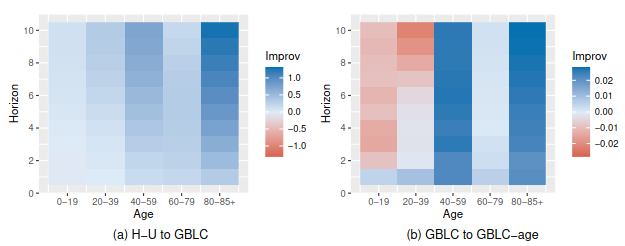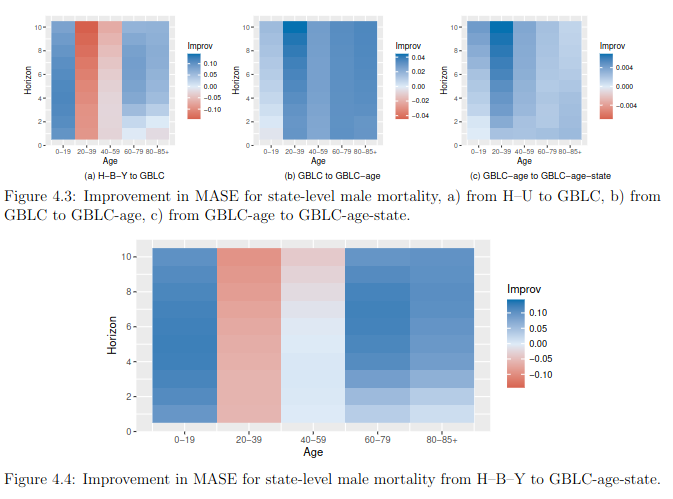Boosted mortality
models with age
and spatial shrinkage
Anastasios Panagiotelis
November, 2023
Joint work with
Li Li Han Li


The big story
- Statistics v Machine Learning
- Boosting or domain-specific statistical models?
- Humans v Machines
- Does domain knowledge about data structure matter?
- Can't we just get along...
The big story
- Statistics v Machine Learning
- Boosting or domain-specific statistical models?
- Humans v Machines
- Does domain knowledge about data structure matter?
- Can't we just get along...

The data
Mortality data (all U.S.)
Mortality data (selected states)
Challenges
- Mortality generally trends downward
Challenges
- Mortality generally trends downward
- But not for all ages...
- and not for all states
Challenges
- Mortality generally trends downward
- But not for all ages...
- and not for all states
- Age effects generally smooth over time
Challenges
- Mortality generally trends downward
- But not for all ages...
- and not for all states
- Age effects generally smooth over time
- Data are noisier for age/states with lower populations and fewer deaths
Challenges
- Mortality generally trends downward
- But not for all ages...
- and not for all states
- Age effects generally smooth over time
- Data are noisier for age/states with lower populations and fewer deaths
- Different states, different patterns
Challenges
- Mortality generally trends downward
- But not for all ages...
- and not for all states
- Age effects generally smooth over time
- Data are noisier for age/states with lower populations and fewer deaths
- Different states, different patterns
- Neighboring states can have similar patterns
The model
Lee Carter model
- A popular mortality model is the Lee and Carter (1992) model.
yx,t=ax+bxκt+ϵx,t
Lee Carter model
- A popular mortality model is the Lee and Carter (1992) model.
yx,t=ax+bxκt+ϵx,t
- The yx,t are log mortality rates for age x in year t.
- The ax are estimated as age-wise means
- The bx are age weights, the κt is a time trend
- Both estimated using SVD
- The ϵx,t are errors.
Gradient Boosting
- Consider a prediction ft=(f0,t,…,f85+,t)′ with squared loss function
Gradient Boosting
- Consider a prediction ft=(f0,t,…,f85+,t)′ with squared loss function Lt(yt,ft)=(yt−ft)′(yt−ft)
Gradient Boosting
- Consider a prediction ft=(f0,t,…,f85+,t)′ with squared loss function Lt(yt,ft)=(yt−ft)′(yt−ft)
- Gradient proportional to residual (yt−ft)
Gradient Boosting
- Consider a prediction ft=(f0,t,…,f85+,t)′ with squared loss function Lt(yt,ft)=(yt−ft)′(yt−ft)
- Gradient proportional to residual (yt−ft)
- The idea of gradient boosting is to
Gradient Boosting
- Consider a prediction ft=(f0,t,…,f85+,t)′ with squared loss function Lt(yt,ft)=(yt−ft)′(yt−ft)
- Gradient proportional to residual (yt−ft)
- The idea of gradient boosting is to fit a weak learner,
Gradient Boosting
- Consider a prediction ft=(f0,t,…,f85+,t)′ with squared loss function Lt(yt,ft)=(yt−ft)′(yt−ft)
- Gradient proportional to residual (yt−ft)
- The idea of gradient boosting is to fit a weak learner, compute residuals,
Gradient Boosting
- Consider a prediction ft=(f0,t,…,f85+,t)′ with squared loss function Lt(yt,ft)=(yt−ft)′(yt−ft)
- Gradient proportional to residual (yt−ft)
- The idea of gradient boosting is to fit a weak learner, compute residuals, refit the weak learner
Gradient Boosting
- Consider a prediction ft=(f0,t,…,f85+,t)′ with squared loss function Lt(yt,ft)=(yt−ft)′(yt−ft)
- Gradient proportional to residual (yt−ft)
- The idea of gradient boosting is to fit a weak learner, compute residuals, refit the weak learner recompute residuals,
Gradient Boosting
- Consider a prediction ft=(f0,t,…,f85+,t)′ with squared loss function Lt(yt,ft)=(yt−ft)′(yt−ft)
- Gradient proportional to residual (yt−ft)
- The idea of gradient boosting is to fit a weak learner, compute residuals, refit the weak learner recompute residuals, etc.
Gradient Boosting
- Consider a prediction ft=(f0,t,…,f85+,t)′ with squared loss function Lt(yt,ft)=(yt−ft)′(yt−ft)
- Gradient proportional to residual (yt−ft)
- The idea of gradient boosting is to fit a weak learner, compute residuals, refit the weak learner recompute residuals, etc.
- Prediction is ensemble of the weak learners
What is a weak learner?
- Typically trees. But can also be
What is a weak learner?
- Typically trees. But can also be
- Logistic regression (Friedman, Hastie, and Tibshirani, 2000)
- Generalized additive models (Tutz and Binder, 2006)
- Copulas (Brant and Haff, 2022)
What is a weak learner?
- Typically trees. But can also be
- Logistic regression (Friedman, Hastie, and Tibshirani, 2000)
- Generalized additive models (Tutz and Binder, 2006)
- Copulas (Brant and Haff, 2022)
- Novel idea 1: Do gradient boosting with the Lee-Carter model.
Exploiting structure
- We know certain things about mortality data.
- Mortality rates of similar ages are similar
- Mortality rates of neighboring regions are similar due to local effects
Exploiting structure
- We know certain things about mortality data.
- Mortality rates of similar ages are similar
- Mortality rates of neighboring regions are similar due to local effects
- Novel idea 2: Shrink forecasts together to borrow strength across nearby age groups and/or geographical regions
How to do shrinkage?
- Add a penalty term to the objective function
Lt(yt,ft)=(yt−ft)′(yt−ft)+λf′tWft
- When Lee Carter model is refit, do not fit residuals, but residuals plus a term involving Wft
How to do shrinkage?
- Add a penalty term to the objective function
Lt(yt,ft)=(yt−ft)′(yt−ft)+λf′tWft
- When Lee Carter model is refit, do not fit residuals, but residuals plus a term involving Wft
- What is W?
How to do shrinkage?
- Add a penalty term to the objective function
Lt(yt,ft)=(yt−ft)′(yt−ft)+λf′tWft
- When Lee Carter model is refit, do not fit residuals, but residuals plus a term involving Wft
- What is W?
- The Graph Laplacian.
How to do shrinkage?
- Add a penalty term to the objective function
Lt(yt,ft)=(yt−ft)′(yt−ft)+λf′tWft
- When Lee Carter model is refit, do not fit residuals, but residuals plus a term involving Wft
- What is W?
- The Graph Laplacian.
- Why does it make sense?
How to do shrinkage?
- Add a penalty term to the objective function
Lt(yt,ft)=(yt−ft)′(yt−ft)+λf′tWft
- When Lee Carter model is refit, do not fit residuals, but residuals plus a term involving Wft
- What is W?
- The Graph Laplacian.
- Why does it make sense?
- Need to think about neighborhoods.
Graph Laplacian
Neighborhood structure for age

Neighborhood structure for states

Graph Laplacian
- Off diagonal elements are -1 if two nodes share an edge, 0 otherwise.
- Diagonal elements are equal to number of neighbors.


Effect on penalty
- Residual for Maryland (MD) adds penalty
(fMD,t−fDE,t)+(fMD,t−fPA,t)+(fMD,t−fWV,t)
Effect on penalty
- Residual for Maryland (MD) adds penalty
(fMD,t−fDE,t)+(fMD,t−fPA,t)+(fMD,t−fWV,t)
- For age 50 add penalty
(f50,t−f49,t)+(f50,t−f51,t)
Effect on penalty
- Residual for Maryland (MD) adds penalty
(fMD,t−fDE,t)+(fMD,t−fPA,t)+(fMD,t−fWV,t)
- For age 50 add penalty
(f50,t−f49,t)+(f50,t−f51,t)
- When we fit the next Lee Carter model it will force forecasts to be closer to its neighbors forecasts.
Putting everything together
- We can shrink across age and states using the following neighborhood structure
Putting everything together
- We can shrink across age and states using the following neighborhood structure
- Same age, neighboring states are neighbors
- Same state, neighboring age are neighbors
Putting everything together
- We can shrink across age and states using the following neighborhood structure
- Same age, neighboring states are neighbors
- Same state, neighboring age are neighbors
- Mathematically we find the Cartesian product of the two graphs.
Putting everything together
- We can shrink across age and states using the following neighborhood structure
- Same age, neighboring states are neighbors
- Same state, neighboring age are neighbors
- Mathematically we find the Cartesian product of the two graphs.
- The graph Laplacian is found by a simple expression involving Kronecker products, see paper for details.
Results
Empirical setup
- Expanding window from 1960−1997,...,2009.
Empirical setup
- Expanding window from 1960−1997,...,2009.
- Make h=1,…,10 step ahead forecasts.
Empirical setup
- Expanding window from 1960−1997,...,2009.
- Make h=1,…,10 step ahead forecasts.
- Use Lee Carter (LC) and three other benchmarks
- Hyndman and Ullah (2007) (H-U)
- Hyndman, Booth, and Yasmeen (2013) (H-B-Y)
- LightGBM (a popular tree based boosting method).
Empirical setup
- Consider four new approaches:
- Gradient boosted Lee Carter (GBLC)
- with age shrinkage (GBLC-age)
- with state shrinkage (GBLC-state)
- with age and state shrinkage (GBLC-age-state)
Summary of results
- At a national level, GBLC and GBLC-age significantly outperform everything.
- At horizons 1 and 4, GBLC-age is significantly better than GBLC.
- At a state level, LightGBM, GBLC-age and GBLC-age-state significantly outperform everything.
- For longer horizons, GBLC-age-state outperforms even LightGBM an GBLC-age.
- These results are based on model confidence sets
National level results
For presentation purposes take averages across 20 year age bands. Figures show improvement in MASE

State level results

State level results
Improvement from GBLC to GBLC-state
Conclusions
- If you have a forecasting model that works in a specific domain, try boosting.
- If you have structure in what you are trying to forecast, consider shrinkage.
Conclusions
- If you have a forecasting model that works in a specific domain, try boosting.
- If you have structure in what you are trying to forecast, consider shrinkage.

References
Brant, S. B. et al. (2022). Copulaboost: additive modeling with copula-based model components. arXiv: 2208.04669 [stat.ME].
Friedman, J. et al. (2000). "Additive logistic regression: A statistical view of boosting (With discussion and a rejoinder by the authors)". In: The Annals of Statistics 28.2, pp. 337 - 407.
Hyndman, R. J. et al. (2013). "Coherent mortality forecasting: the product-ratio method with functional time series models". In: Demography 50.1, pp. 261-283.
Hyndman, R. J. et al. (2007). "Robust forecasting of mortality and fertility rates: A functional data approach". In: Computational Statistics & Data Analysis 51.10, pp. 4942-4956.
Lee, R. D. et al. (1992). "Modeling and forecasting US mortality". In: Journal of the American Statistical Association 87.419, pp. 659-671.
Tutz, G. et al. (2006). "Generalized Additive Modeling with Implicit Variable Selection by Likelihood-Based Boosting". In: Biometrics 62.4, pp. 961-971.